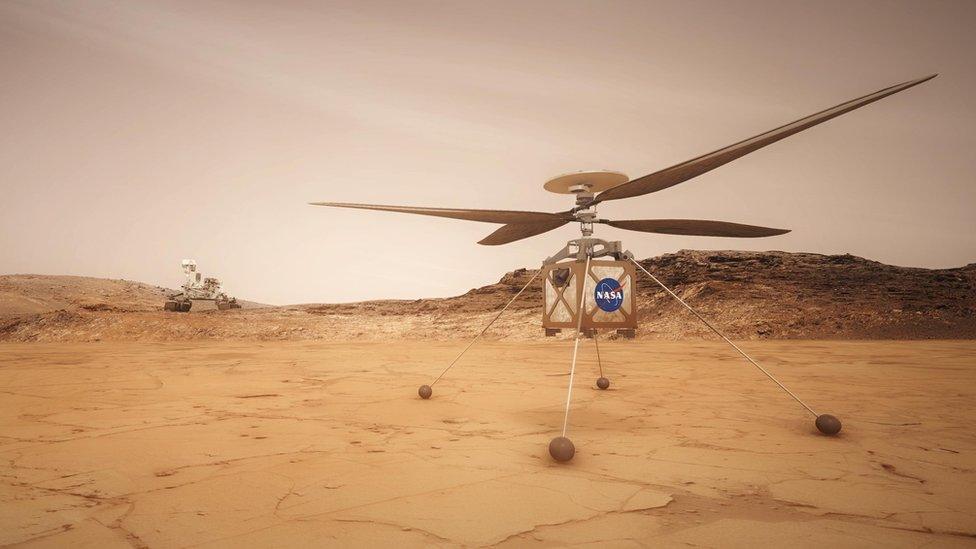Ingenuity: Nasa extends its Mars helicopter's mission
- Published
- comments

The US space agency Nasa, is extending its helicopter's mission on the Red Planet.
Ingenuity successfully completed three flights on Mars, making history in being the first helicopter to fly on another planet.
The space chopper will now move on to helping Nasaβs Perseverance Rover hunt for signs of life on Mars.
This new 'operational phase' will last for another 30 Martian days, but Nasa said it is hopeful Ingenuity's quest could be extended further.
Nasa Ingenuity: First ever helicopter flight on Mars
βThe technical performance has been fantastic and it is exceeding all our expectations,β said MiMi Aung, Ingenuityβs project manager.
βI can't tell you how excited we are about this new phase.β
What happened during the first helicopter flight on Mars?
Ingenuityβs flight on 19 April made history as the first powered, controlled flight on another planet.
The 1.8kg chopper lifted off into the Martian atmosphere and hovered at a height of 2m for about 40 seconds before landing.
For its second and third flights, it flew a bit further, rising to a height of 5m before speeding off for 2m and then 50m before heading back to its landing spot.
The shadow of Ingenuity can be seen on the ground in this shot taken mid-flight
Why are the flights a big deal?
Flying a helicopter on Mars is no easy task.
The atmosphere on the red planet is very thin, which means the helicopter does not have much air to "bite" into, so its rotors have to spin faster than on Earth.
Two 1.2 metre long rotors spin in opposite directions at up to 2,500 rpm (revolutions per minute).
The rotor tips need to move at about two-thirds of the speed of sound, this gives Ingenuity the lift it needs.
Another thing that makes flight on Mars tricky is that the planet's gravity has much less pull than here on Earth - and even though this might help, Ingenuity still has to be very light.
An image taken from helicopter of Mars' surface
What is next?
Nasaβs original plan was to then carry out two more flights, before grounding Ingenuity permanently.
But Nasa's latest announcement is a change of heart. The US space agency said it was so pleased with the helicopterβs performance, it wanted to find out how much Ingenuity is capable of.
Bob Balaram, Ingenuityβs chief engineer, said: βIt's been riding the winds, it's been taking off great, all the engineering systems, the solar panel, the battery, the radio have all been working very well - everything has just been fantastic."
The helicopter will now move on to helping the rover's science programme.
Watch the moment the Nasa Perseverance rover landed on Mars
It will work with the Perseverance robot as it starts to investigate Jezero Crater, a region of Mars that was once a lake.
The rover will be looking for rock samples that it can study with its onboard instruments and tools. Its ultimate aim is to find signs of life.
The helicopter will start scouting for geological features and exploring areas that Perseverance cannot reach, as well as making digital elevation maps which can help scientists to better understand the terrain.
But this will mean flying higher then it has already, which is risky.
"We will now be flying over unsurveyed terrains and transfer to airfields that are not well characterised so there's a higher probability of a bad landing," explained MiMi Aung.
"We will be celebrating each day that Ingenuity survives and operates beyond the original window."
- Published19 February 2021
- Published20 February 2021
- Published6 March 2021
